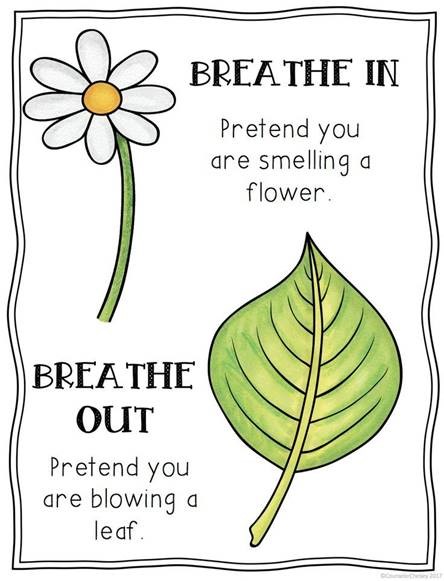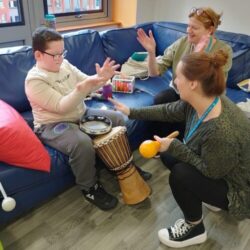
Slowing down, breathing, feeling calm …
What does that mean? Well, it’s a bit like slowing down the whizzing and whirring of your mind OR taking a little holiday away from that busyness.
Have you ever felt like:?
- You can’t quite catch your breath?
- Your tummy is doing somersaults and making you feel sick?
- Your skin has pins and needles all over it or feels itchy?
- Your legs or knees feel all jumpy?
These kinds of feelings usually come from thoughts, your body is reacting to what’s going on in your mind. There are lots of different ways to help you manage this and take control back over your body. I’m going to share some ideas with you in this article.
The main thing to remember is that these are tools that you will need to practise; the more you use them, the easier they get to do and the faster they help you to get back into the driving seat of your mind and body. When you feel the physical effects of what your brain is thinking (like in the bullet points above), your central nervous system is taking over. Using good relaxation techniques helps you to control the feelings that have caused this chain reaction. You can read more about this in the article called ‘I feel Anxious’ if you’re interested.
Mindfulness – slowing everything down
Have you heard of something called ‘mindfulness’? It’s about noticing what is happening right now, in your body, your brain and in all of your senses – hearing, sight, touch, smell and taste.
Really focusing on what is happening to you in the here and now can help you to concentrate. Practising being mindful every day helps you to pay more attention to yourself and notice thoughts and feelings. For example, wherever you are reading this right now, take a minute, look around and notice:
- what you can see?
- what you can hear?
- what can you smell?
Now let yourself notice:
- How your body feels – is it calm, relaxed, fidgety, are you comfortable?
- How your clothes feel – are they loose, tight, hot, warm?
- How your brain feels – is it calm, racing, full of thoughts, empty?
It can feel a bit weird to sit and just allow yourself to ‘be’ in the moment, but with practise, it can really bring benefits of calmness and ways to manage when you feel overwhelmed with tough emotions or overloaded with stress, worry or anger.

Being able to focus and concentrate can have lots of really positive impacts on your friendships, family relationships and even help you to achieve more with sports, school, music or in other hobbies or interests.
Doing regular Mindfulness activities is a way to exercise your brain – making it strong.
When you exercise your brain, you help it to create new neural pathways so you can change the way you think and behave. If you feel like you stress quite easily or big feelings get on top of you a lot (and many people do feel like this!) then some of the ideas in this article could be helpful to you to try something different and create those new pathways in your brain (for any geeks like me out there, this is what neuroplasticity is all about).
Okay, so you know what mindfulness is, what now?
Well there are literally 100’s (if not 1000’s) of ways to do this. Mindfulness is a bit of an umbrella term and includes things like we’ve mentioned above about changing the way your brain thinks but also stuff around:
- holding your thoughts
- breathing
- anchoring/grounding
- looking for the positive things in life
It is often the case that people find one particular area better for them to use or understand and not others, so it’s really up to you to give things a go and see what does and doesn’t work. Let’s break these down a bit more….
Holding your thoughts
These exercises can help your mind to feel calm and still. It is not unusual for people to find it pretty hard to do at first, but practising (every day if you can) will make this feel easier and become more of a habit for you.
- Be The Pond => https://www.youtube.com/watch?v=wf5K3pP2IUQ. This is an example of guided mindfulness; it lasts for just over 5 minutes.
- A Mindful Walk => this probably sounds a bit funny, but if you like being outdoors making yourself really notice what is around you using as many of your senses as you can (hearing, sight, touch, smell and taste), then it is a brilliant way to help yourself feel calm and peaceful. Here’s what you do:
- Stand up ready to walk, take in a few really deep breaths (see some of the breathing ideas below). Feel your body relaxing from head to toe
- Smile … this action tells your brain that you are about to do something you can enjoy (it really does!)
- As you set off walking, focus on each step as you lift your foot up and then place it back down again – really tune into what your feet are doing. If you are not walking on feet, then really focus on the sound of the feet of the person with you or the noise and sensation of the wheels underneath you as you travel forward
- Notice how you are breathing, how the breath feels in your chest as you move
- Every couple of minutes, stop and notice one thing – a flower, a leaf, a bird, a tree, a stone, a stick, running water, the wind; anything that you can see, hear or feel nearby. Stand still, spend a few moments just to experience what you have noticed
- If you feel your mind wandering and that you are thinking about other stuff, that’s ok, just bring it back to notice where you are and what is around you
- Continue on with this until you feel calm and settled
You can do this kind of mindful walk anywhere at any time.
Breathing
Ok, I know you know how to breathe J In mindfulness, being aware of how you are breathing is important, because if you notice it changing, you can do something about it if you need to. These exercises can help you control your breathing if you feel very worried, panicked or angry.

Flower & Leaf breathing (good for very young children, age 3-5)
Balloon breathing (good for young children, age 4-8)
- Imagine there is a balloon in your tummy. Take a big, deep breath in through your nose …
- As you do this, try to fill up that balloon so that your tummy puffs up
- Now breathe out through your mouth (like blowing a bubble) and let all of the air out of the balloon
- Take slow breaths whilst you do this, try to count to four as you breathe in and again to 4 as you breathe out, like this:
- Inhale (breathe in), 2, 3, 4 …
- Exhale (breathe out), 2, 3, 4 …
- Repeat this until you feel calmer

Star breathing (good for young children, age 6-9)
You can draw a star on a piece of paper or imagine one in your head, then follow the directions on the left.

Take 5 Breathing (good for all ages)
Anchoring/Grounding
Anchoring or grounding is the term given to helping yourself to feel safe in the present moment and connected to everything around you. There are lots of ways you can do this and they are often about getting your brain to think about what each of your senses can see, hear, touch, smell or taste.
If you feel worry or panic, these kinds of exercises can be very helpful to do because they force the part of your brain that is sensible and calm to take back control from the part of your brain that’s losing control and sending you messages of panic.

The 54321 technique
Once you’ve been able to ‘ground’ yourself, you can focus on your breathing to get that to calm down to your normal rate (why not try one or two of the breathing exercises on the left).
ABC sights, sounds & smells
Wherever you are, take a moment to look around you and in your head (or out loud) say what you can see, hear or smell starting with A, then B, then C and carry on to see how far you can get down the alphabet.
Give yourself a cuddle!
Feeling a calming but firm pressure is helpful for grounding – and you don’t need anyone with you to do it! It’s helpful to do this whilst thinking in your head (or saying out loud) “I am in control” or “I am safe right now”.
As you’re saying or thinking this, place your left hand on your right shoulder and tap, then your right hand on your left shoulder and tap – take it in turns to tap each shoulder. Then squeeze your hands around your shoulders to give yourself a strong hug, go back to tapping your shoulders – one, two, three tap, then squeeze, back to one, two three, tap, then squeeze.
Repeat this as many times as you need to. (For anyone who has also read the “I feel anxious” article, it mentions about the brain sending chemicals around your body, well when you are hugged by someone, or you hug yourself it helps your brain to release something called serotonin which helps you to feel happier)
Connecting with yourself
Sometimes, when things happen that make us feel very strong emotions, it can make us feel a bit lost. When we feel very sad, worried, angry, anxious (or other big feelings) a lot of the time, every day, our brains can feel a bit foggy and it’s hard to concentrate. Running through some simple reminders in your head (or out loud) can be helpful – in counselling, we call this “re-orientation”. Examples could be that you finish off these sentences and you repeat them back to yourself until you feel calmer and more settled:
- My name is…
- I am … years old
- I am in… (place that you are)
- Today is…
- My birthday is on…
- The season is…
- The weather is…
- I am wearing…
Looking for the positive things in your life
Some people find it helpful to focus on the really nice things in life, or things that they feel grateful for or happy about. This can be known as a Gratitude exercise and there are lots around on the internet – here’s an example of one:

Summary
So, what do you think? Can you see yourself using any of these?
Have a little go with any of these that you like the sound of.
These are all possible tools to help you promote a calm, relaxed mind. They can be really useful when you feel stressed, anxious, panicked, worried or just not yourself.
Practising these when you are feeling good and calm are great ways to try and make them feel more of a habit so when you really do need them, you can remember them and use them easily and quickly.
If you wanted to meet with one of our counsellors to practise these kind of exercises – we would be very happy to do that.
You can see all of our pictures and a bit of information about us on this website under the link “Introducing the team: Counselling – what’s it all about?”
Remember too, you can come back and read this article any time you like, however many times you like. Returning to look or read again can be useful to help you remember some of the key messages and tools.
References
Breathe in (daisy), breathe out (leaf) => https://images.app.goo.gl/izeohchLbYLJiMWL7
Balloon breathing exercise taken from => www.therapywithcarolyn.com



